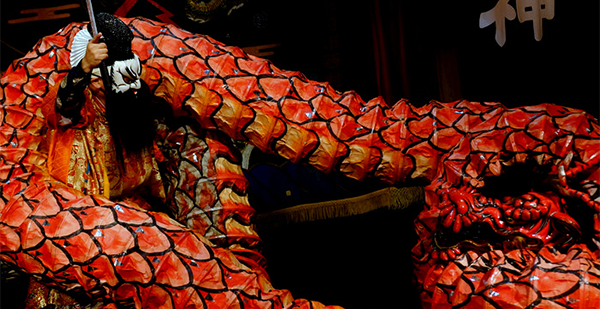Iwami Kagura at a Glance
Essential information about Iwami Kagura, loved, carefully protected, and passed on by the local people.
Photos:Ai Nishimura
Continues to evolve while preserving tradition.
Features of Iwami Kagura
Iwami Kagura was originally a Shinto ritual performed at shrines throughout the night to express gratitude to nature and the gods during the autumn harvest season.
Later, as times changed, it came to be enjoyed by a wide range of people and changed into the stage events and performances that we know and love today.
Iwami Kagura is still evolving today.
The great appeal of Iwami Kagura lies in the fact that it is preserved and passed down through generations with a fusion of the faith of carefully preserving the good old traditions and passing them on to the future and the spirit of constantly introducing new culture without being bound by conventional styles.
Hero defeats the bad guys! A simple,
clear story for everyone to enjoy.
Iwami Kagura has a variety of performances and most of them are about Japanese mythological heroes.
In the Orochi, Susano-o brilliantly slays the rampaging Yamata-no-orochi.
A typical Onimai Kagura, Jinrin, is where two gods and two demons confront each other.
The simple and clear so-called rewarding good and punishing evil, such an exhilarating story is easy to understand even for people who view Iwami Kagura for the first time.
Many small children are enthusiastic about Iwami Kagura, as anyone can enjoy it without any prior knowledge.
The magnificent performers are local people.
Iwami Kagura is a part of their daily lives.
The word traditional performing arts may sound a bit formal to many people, but Iwami Kagura is just fun.
For the people living in the Iwami region, kagura is a part of their daily lives.
Ever since they were kids, they would go to shrines to watch kagura and have a good time with families and neighbors.
It is an exciting event for children because they are allowed to stay up late only on the nights when kagura is performed in the autumn.
The uncles in the neighborhood, who are usually ordinary adults, transform into a superhero on a Kagura night and brilliantly punish evil.
“That’s cool! I want to dance like that one day!” Every child in Iwami has such a dream.
Children will grow up and become adult, then gather together to practice kagura like an after-school club.
This is how much Iwami Kagura has integrated into the lives of the people in Iwami.
Kagura is anywhere in Iwami all year round.
View the traditional kagura.
If you want to see Iwami Kagura, you can check the schedule of kagura performances held throughout the year at various places in Iwami.
On weekends, there is always a kagura performance being held somewhere.
If you want to enjoy Iwami Kagura in a casual style, visit the Iwami community hall, the outside stage at the rest stop and shrines in the hot spring district. You can see different performances in various locations.
For the experience of more authentic performance, the votive kagura performance in autumn is highly recommended.
Originally, the kagura was performed as a part of a festival for local residents, but many venues are now open to tourists.
Many performances are held throughout the night, and it is fun to watch them in your own style while enjoying a drink.
Also, the Umikagura, which is performed only once a year in Yunotsu, is one of the most popular events among the Iwami Kagura.
You will be amazed by the superb kagura dance with the spectacular sunset over the Sea of Japan in the background.













